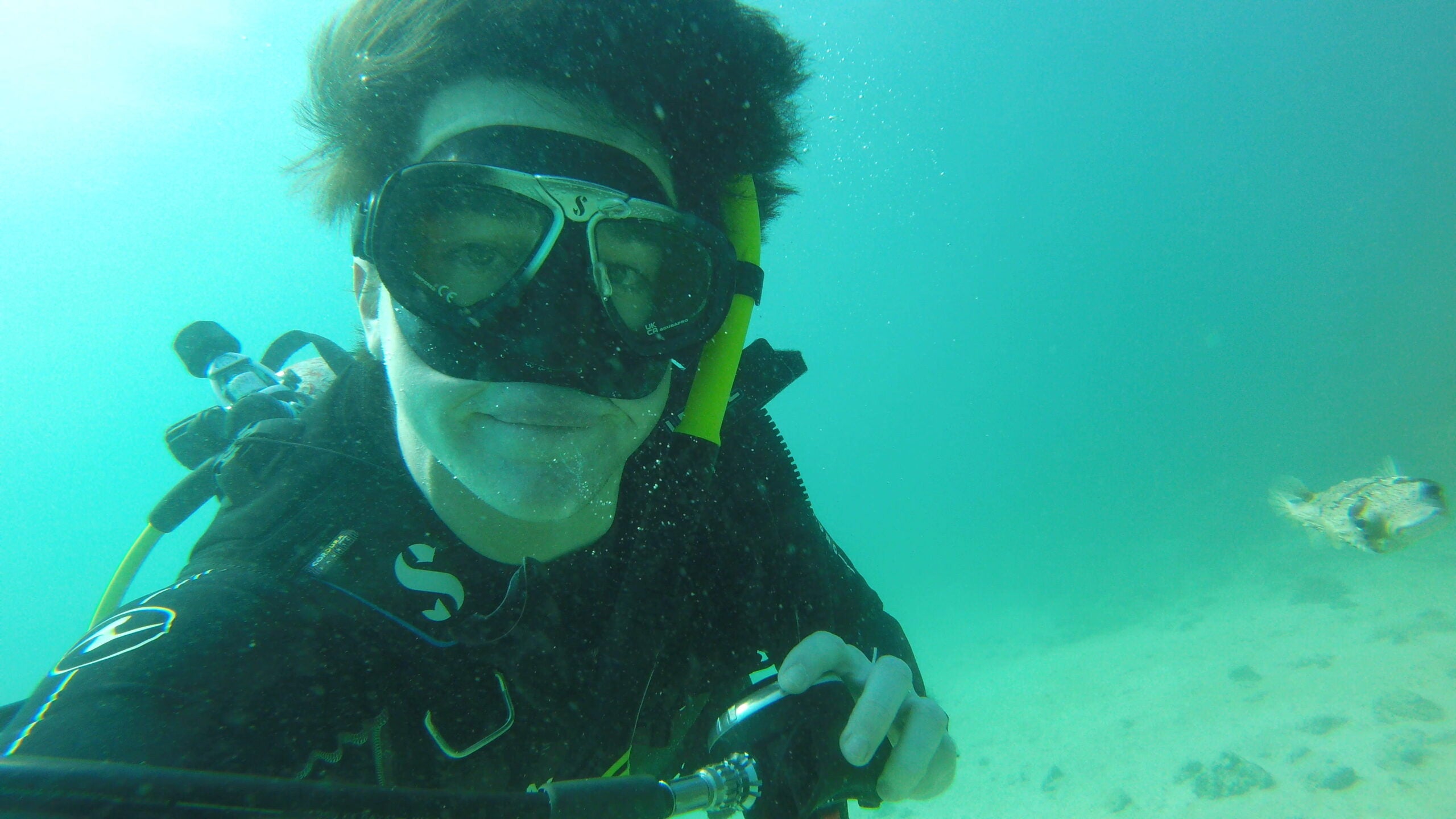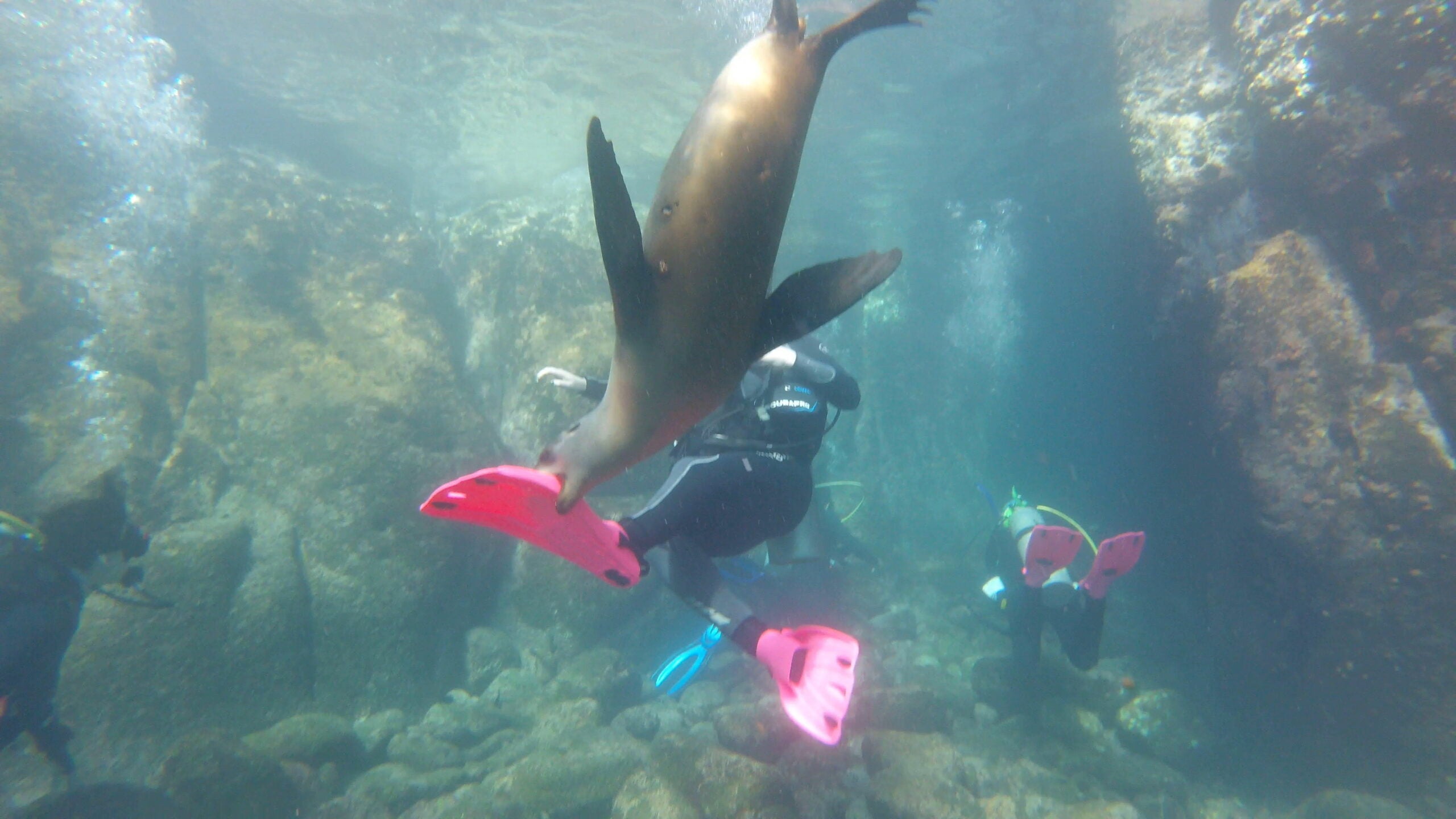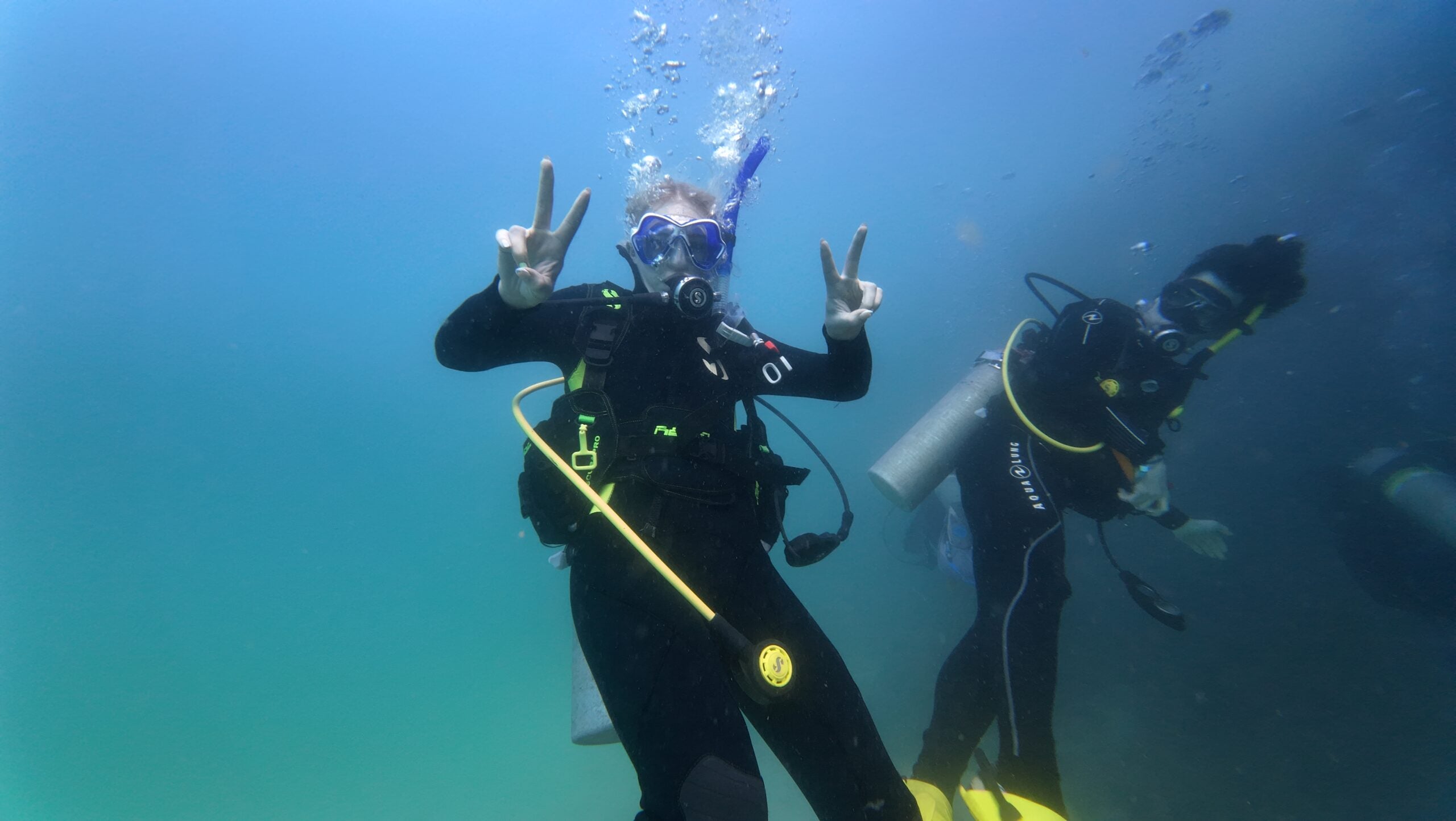In early December, Shawn Simonson, professor in the Department of Kinesiology, and his Graduate Environmental Physiology students, as well as three guests traveled to La Paz, Mexico to explore the concepts they learned throughout the fall semester.
In the class, students learned how different environments affected the human body, this included high elevations, extreme cold, and the high-pressure environment of the ocean. In the lab associated with the class, students became scuba certified at local dive shop, Dive Magic. This gave them each basic experience with scuba diving and an introduction to how their bodies would be affected by going under the water.
At the conclusion of the semester, to continue their learning and as a reward for all of their hard work, they traveled to warmer weather to explore the ocean and apply their new found knowledge of environmental physiology. Here are each of the students and their favorite parts about the trip.
Calvin Doerr: First Year Master’s Student

I was so excited to take this class because I knew that I’d be able to travel to Mexico! This trip was truly phenomenal and introduced me to so many things I’d never seen before. In just one week, I was friends with a puffer fish, got bit by a baby seal, and swam into a whale shark!
Back in Boise, at the beginning of the term,, we started our course by learning the pertinent physics and about the ocean animals and the adaptations they’ve developed over thousands of years to help them live in their unique environments. This included microscopic particles called dinoflagellates and large deep-sea animals like sharks. We discussed how their bodies responded to sound, light, pressure, and temperature. Later in the semester we learned how human physiology is affected under the water, and found similarities between ourselves and the animals of the ocean. At this same time, we were beginning to dive in the small pool at Dive Magic. We were able to put what we learned into practice. We noticed the changes in pressure as we descended, and learned how to control our buoyancy, which proved very helpful when it was time to hop in the water in Mexico.
During our first dive, I was fascinated by everything that I saw, and on every dive we saw something new. My favorite activity of the week was when we went snorkeling with whale sharks. Because they are a protected species, we were not able to wear our full scuba gear, so we jumped out of the boat with just fins, masks, and snorkel. We got to swim right next to the massive animals as they fed on plankton at the surface. Our tour guide told us we were very lucky because he had never seen so many whale sharks feeding at the same time, which made for a lot of vigorous swimming in between whale sharks. At one point, I tried to swim around one whale shark to get a better view of its side and ended up swimming right into another whale shark as I crossed the huge animal’s path. The animal was not interested or phased in the slightest, and continued on their way. As I took a breath, processing what had happened, our captain pointed out a giant manta ray as it swam right in front of me, and I changed my path to follow it.
This trip was a humbling experience. As we go through our lives, we are rarely faced with the size of the world around us. Every time we descended beneath the surface, I had to confront the vast ocean around us, and it was uncomfortable to think that as a human I was not at the top of the food chain. As we swam through schools of fish I could see the organization of underwater life, and it felt like we were visiting another planet. I found a greater appreciation for our oceans and left feeling so grateful for this earth!
Calais Schneider: First year Masters student.

Like many of the big adventures I have had in my life, I had no idea I was about to embark on a week-long trip that would create life changing memories until about roughly three months prior. I was hesitant at the beginning of the course on whether or not I should go, but thanks to some much needed encouragement from fellow classmates and Dr. S, I quickly bought in and signed myself up. I mean, a whole week spent swimming and diving under the hot sun of Mexico in the dead of winter? Who wouldn’t want to go? Little did I know that when it did finally come time to explore our world below the surface, it would leave me with a new found love and appreciation for just how incredible the natural world can be.
When initially enrolling in the environmental physiology course, I was coming in as a fresh-faced grad student who had a desire to learn all about how the human body responds to differing extreme environments, with only a brief scuba diving experience in a small pool back in my sophomore year of college. Throughout the semester we learned about how our bodies function under the water, and how we can adapt to survive the extreme pressures of the ocean. Mental and physical preparation were vital factors in ensuring we were ready to dive once we reached the ocean come December, and so our semester-long training commenced.
While we filled our brains with the knowledge and understanding of the similarities and differences humans share with the creatures of the sea, we also spent our evenings beneath the surface of the Dive Magic training pool, learning important scuba skills that we would need to utilize on our trip. Training in and out of the water was rigorous, and at one point I was required to stand on my head while my teammates collected my blood pressure (I’m still not totally sure when a moment like this may arise during a dive, but hey, I’m no Dive Master.) After weeks of preparation and hard work learning all about human physiology in hyperbaric environments, Dr. S finally deemed us ready for our oceanic expedition.
Our trip to Mexico had finally arrived, and I couldn’t have been more excited to get the chance to see up close and personal the flora and fauna of the Baja Sur that I had grown up watching on countless nature documentaries, and I was not disappointed. Immediately upon our first dive near a coral reef I was welcomed by a variety of multicolored fish, and an array of unique marine plants and invertebrates. I found it fascinating to watch and learn how these creatures interacted with each other to build such complex and unique ecosystems that are so vastly different from anything I had seen or experienced before. My fascination and wonder of the underwater world didn’t end there. Throughout the week we dove through sunken ships that had become artificial reefs, visited sea lion colonies with curious pups convinced that our brightly colored fins made perfect chew toys, and cruised with pods of dolphins as they casually surfed our boat’s bow wake. While all of these experiences left me awed and amazed, my favorite moment however, came from a moment of total unison and harmony.
While diving near a lighthouse, a large school of sardines had been herded into a tight bait ball by sea lions and seabirds. Hundreds of sardines all moving as one created bright flashes as sunlight glinted off their silver scales. As they swam near me I would reach out my hand, and in an instant the wall of fish would dart off in the opposite direction, not a single fin out of formation. It was truly amazing to see just how intelligent and creative these creatures could be. By swimming in unison they can create illusions with light and their scales in order to disorientate their predators. At one point as I gazed around in every direction, the bait ball smoothly swam to form a circle around me. Suddenly I was inside the giant school, and was taken aback by the sheer number of fish surrounding me. It felt like something straight out of virtual reality, except this was very much real. Despite the fact that I was much larger than these fish, and absolutely not something that looked like I lived in the ocean, the sardines somehow knew I posed absolutely no threat to them. It was probably due to my clumsy movements, and slow swimming speed, that gave them an impression along the lines of “no way this thing is catching a single one of us.”
This trip was truly one of a kind, and I feel incredibly lucky to have gotten the chance to explore our world under the sea. It has brought me a new understanding and appreciation for the world we live in, and nature that forms its uniqueness. My time spent in La Paz has forever changed me, and I know that I will spend the rest of my life forever fascinated by our blue planet.
Katie Lysne: Fourth Year Undergraduate Student

Environmental Physiology and the accompanying excursion to Mexico presented me with many “firsts,” both academically and in my personal life. I was initially introduced to the concept of environmental physiology in the spring 2024 semester, when Dr. Simonson presented his class and the corresponding trip to La Paz in one of my lectures. As someone who had previously never traveled outside of the United States, I was very interested in the class and the opportunity to better explore our natural world. In fact, I knew I would be registering from day one.
As an undergraduate student, I faced many “firsts” before my feet even touched the surface of the water. I had no idea what to expect from a graduate course, and I wasn’t sure if I possessed the academic qualities of a graduate student. Furthermore, I was the only undergraduate student enrolled in the class! Despite my initial anxiety, I found that I greatly enjoyed working with my peers and engaging in the class content. The work was challenging and different, but provided me with new ways of learning and a chance to explore topics that were not included in my regular curriculum. We learned about the physiology of deep sea divers, astronauts, high-elevation communities, and sea creatures of all kinds. I began to think more critically and to be more aware of our impact on the planet. I even became comfortable with stepping outside of my comfort zone and trying new things!
After successfully navigating the initial weeks of the semester, I was faced with another “first” – scuba diving. Although I learned to swim early in life and greatly enjoy aquatic sports, I never had the opportunity to engage in such an activity. Like any learned skill, scuba diving required time and effort to become proficient. However, unlike sports that occur on land, scuba diving added another component: water. Humans are not designed to live underwater, which presents challenges – especially to a new diver. A small mistake can be deadly, even if others are close by. Because of this, a rigorous certification program is necessary for all new participants. For many weeks, my classmates and I spent time practicing our diving skills in the contained space of the Dive Magic 12-foot pool. We learned how to remove and replace our masks underwater, what to do if we ran out of air, and how to avoid life-threatening accidents such as ascending too quickly. At the end of November, I had finally gained my open water diving certification and was ready to explore the salty Sea of Cortés.
My first trip outside of the US was everything I had imagined and more! The 32 degree Boise winter became a distant memory in the 75 degree sunshine. Even in the winter months, La Paz had beautiful weather and excellent diving conditions. Our days were filled with boat dives, delicious food, diverse sea life, and unique opportunities that many people will not ever encounter. Dive equipment was available on site, and the water only a few steps from the hotel. Every night, we headed into La Paz for dinner. I ate the most delicious seafood, even though I have avoided seafood for most of my life. Every morning at 9 a.m., we departed for another day filled with new dives and experiences. We saw all types of fish, swam with sea lion pups, explored shipwrecks, and became acquainted with our Dive Master Pedro, who guided us through all of the dives. We even saw dolphins swimming beneath the boat on three separate days. It was incredible to experience the ocean life in front of my very eyes! On the last day of the trip, we snorkeled with whale sharks that were in residence for the winter months. Despite the frightening name, whale sharks are filter feeders and will not harm humans. In fact, the only frightening thing was their size! Even the juvenile sharks were two to three times larger than we were. It was captivating to see such a large species swimming peacefully alongside me. A few months ago, I never would have guessed that an endangered species would be within arm’s reach.
La Paz was an experience that I will never forget and will continue to shape my life as I work towards my academic and personal goals. I have learned that “firsts” may be uncomfortable and challenging initially, but may become the best decision you’ll ever make. If I hadn’t challenged myself to step outside of my comfort zone, I would have never gotten to experience such incredible things. I will always be in awe of our planet and the life beneath the blue sea.




